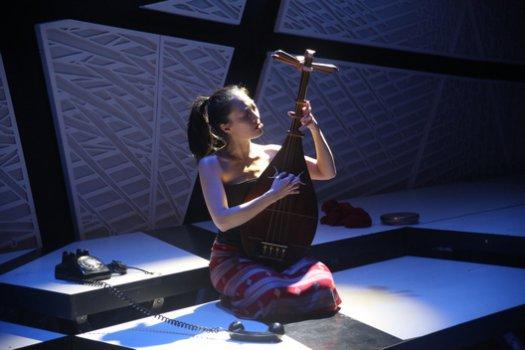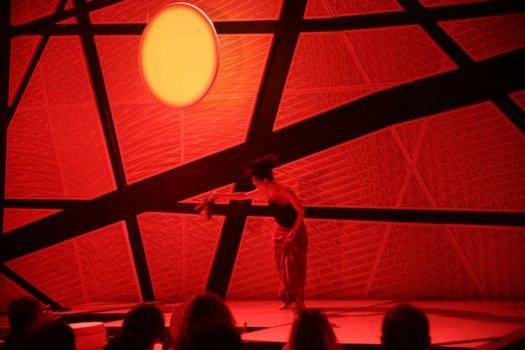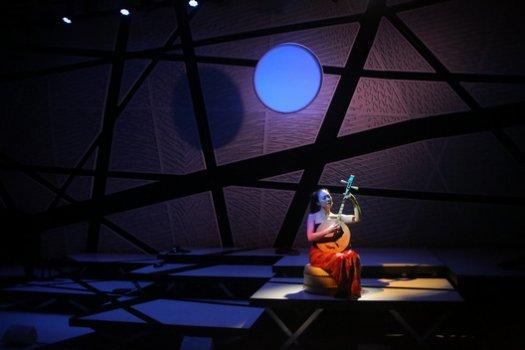Jen Shyu: Nine Doors

Jen Shyu in performance (Photo credit: Steven Schreiber)
[avatar user=”Jean Ballard Terepka” size=”96″ align=”left” ] Jean Ballard Terepka, Music Critic[/avatar]In Jen Shyu, gifts and talents, artistic creativity and keen intellect alternately compete and collaborate. The results, as evident in the recent world premiere of her Nine Doors, are fascinating and thrilling.
Shyu sings in English and in several ancient and modern languages Asian languages, interpreting traditional, contemporary, poetry and prose texts. She plays instruments as varied as gayageum and soribuk drum, moon lute, biwa, piano and gongs. The Nine Doors program notes elaborate.
After fifteen years of formal study, Shyu incorporates five distinct music traditions in her newest work: “epic storytelling (Pansori), East Coast shaman music (DongHaeAhnByeolShinGut), and Binari, usually performed as a blessing for an audience, all from Korea; music from sub-districts Aileu and Atauro ferom East Timor; Hengchung Folk Song with moon lute from Taiwan; Ledhekan, which combines Javanese dance with improvisational singing (Sindehenan) from Indonesia; and the ‘speaking-the-song’ or ‘katari’ with Japanese bias, the rare 4-stringed instrument originally used by monks and priests.”
Shyuh performs ancient dances; in her presentation of inherited ritual gestures, she makes sensuality mysteriously meticulous; only gradually, over the course of the evening, does her traditional dancing become more apparently natural, embodying a more accessibly international form of universality. She engages with the audience as intimately, directly, disarmingly, flirtatiously and imperiously as a cabaret singer, a supremely experienced one-woman-show artisan.
Then, in a single movement – a transformational pass in time – she becomes a voluptuous temple sculpture danced into life; or a lieder singer; an ageless priestess spinning grief into blessings. Her intellectual command of languages, complex myth systems and international cultural history gives her the vocabulary of her artistry: she creates her own densely elegant macaronic, a sustained exercise of constantly shifting immersions in one linguistic, cultural, intellectual and artistic tradition after another.
This – all of this at once – is Shyu’s material. It is the creative language she uses to tell her Nine Doors story.

Jen Shyu in performance (Photo credit: Steven Schreiber)
Shyu presents an account of the car accident death of Sri Joko Raharjo, “Cilik,” Javanese shadow puppetry master and friend of Shyu, and of the unexpected survival of the master’s young daughter, guided in the growth of her understanding of life’s meanings by powerful female legends whose archetypical stories Shyu tells. The arc of the nine-scene piece moves from Shyu’s own shock and lament in the face of tragedy through her own renewed ability to find life after death by means of extended story-telling to a conclusion of affirming meditation on the merged confluence of life and home.
Each of the nine pieces – each door – is set to a different text: modern newspaper, orally transmitted myth, “retrieved” ancient poetry, contemporary prose-poems, personal songs. Each of these exerts its own pull of allusions, assumptions and contexts. Myths that vibrate with timeless familiarity are set next to writing by a poet, Edward Cheng, whose death only two years ago elicits Shyu’s interconnected presentation of celebration and loss.
The experience of seeing and listening to Shyu’s Nine Doors is at once unnerving and exhilarating.
Shyu’s strength as an artist is the confident certainty of her invitation: once she has your attention, she merits your trust. She will take you with her; she will not drop you by the wayside; she will never withdraw her gifts from you.
But she doesn’t explain them. Her art is religious, not pedagogical. In spite of the invaluable, almost exegetical program notes, her story-telling is not accompanied by explanatory conclusions; instead, it suggests more stories … more mysteries, more riddles, jokes and surprises, more urgent summonses to find the figures casting the shadows.
For a Western-bred, Western-schooled audience member determined to find some cerebrally linear way of keeping up with “what’s going on,” the project is almost impossible. Bearings in one scene-song-story are barely established before the entire linguistic, atmospheric and narrative geography shifts into another one; connections from one to the next may or may not be, for the “foreign” audience, clear. All sorts of intellectual pleasures, for those who don’t have access to Shyu’s encyclopedic vocabularies, hang too far away to reach. There’s just enough English in this piece and enough universality of look, sound and movement to give one a sense of all that one’s missing. But that’s frustrating.
Yet the rewards of Shyu’s Nine Doors outweigh its frustrations.

Jen Shyu in performance (Photo credit: Steven Schreiber)
Shyu’s subject is the experience of transformation as the means by which human beings can connect with each other in the process of making meaning. To say that birth and death are universal to all humanity is, in the end, uninteresting. What’s compelling, what’s enduringly exciting is to learn how changing – the process of ending one thing to become another or of abandoning an old idea to take up a new one – reveals universality.
Shyu’s fascination with the “Wehali Kingdom’s Ati Batik Story,” which she tells in two separate iterations in Doors Five and Eight, revolves around notions of power, gender and perception. Ribald trickery upends staid complacency; security is undone. “That king was a woman!” Pursuit of more truth is foiled for the moment, but “The new moon appears,” and the cycle of tricks and truth in competition begins again. Ati Batik’s legend involves brothers and sisters, youngest and oldest, witless and wise. The Baridegi story focuses on a different family dynamic: a daughter brings the Water of Life from the underworld to resurrect her father. Here, a child gives life to a parent: originating principles are both reversed and affirmed.
Interspersed among the story-scenes of the Nine Doors are “pure” songs. “Blink of an Eye – A Cure for the Heart’s Longing” (Door Six) and “Kaze no Denwa” (Door Seven) – are ethereally lovely pieces. Neither “Western” nor “Asian,” they are both technically demanding in terms of their instrumentation (on Taiwanese moon lute and on biwa), and Shyu’s singing emerges entirely from an organic blurring of styles and traditions that is uniquely her own. Wistfulness, longing, weary sadness and then fragile hope are all conveyed in Shyu’s surprising, flexible voice: earthiness and ephemerality are equally at her command.
The final piece, “Contemplation,” an expansive meditation by Edward Cheng set to music on the gayageum composed by Shyu, was a beautiful conclusion to this extended nine-piece work. An original song by Shyu, it presupposed in its musical identity all the dense history that preceded it; it was an assertion that next will always come, and that it will be here, right where one is. Upheaval and destruction, loss and confusion always give up new beginnings: there is never a definitive end, only change. Circle and line can co-exist as formulas for making meaning; transformation is a continuum we all inhabit. Shyu’s final delicately, mournfully offered “life … home … life … home” were whispers of affirmation.
Nine Doors is clearly Jen Shyu’s vision. She has been engaged with this material and these subjects for several years; she first considered them after Cilik’s death in 2014 and presented some of these ideas in Song of Silver Geese in 2016. In Nine Doors, the shaping of her vision was assisted by gifted colleague artists who suggested the work’s spare, clean props, lighting and stage direction. In spite of the almost always effortless deftness of Shyu’s stage presence, Nine Doors is a dense and demanding work. It might need tougher editing for tightness. Or it might need expansion, a separating out of the myth material from the emotional narrative. As Shyu continues to live with this material and perform it in different contexts – as she clearly, appropriately, is sure to do – Nine Doors may change somewhat in shape.
But witnessing, and therefore participating in, its premiere was exhilarating: Jen Shyu is remarkable.
Jen Shyu: Nine Doors (June 29, 2017)
World Music Institute in association with Asia Society
National Sawdust, 80 North 6th Street, in Brooklyn
For more information, visit: http://www.jenshyu.com, http://www.nationalsawdust.org, http://www.worldmusicinstitute.org, or http://www.asiasociety.org
Running time: 50 minutes without an intermission.






Leave a comment